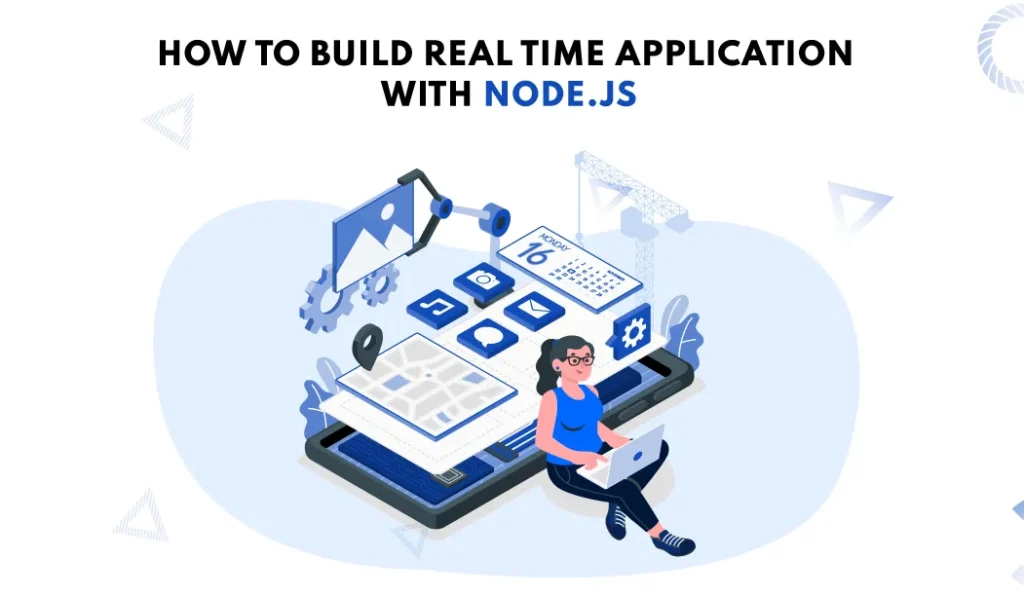Real-time web applications have become essential for various use cases, such as live chat, gaming, notifications, collaboration tools, and more. Node.js, known for its event-driven, non-blocking architecture, is a popular choice for building real-time applications due to its speed and scalability. Paired with libraries like Socket.IO, it enables real-time, bidirectional communication between web clients and servers.
In this blog post, we’ll explore how to build real-time web applications with Node.js and Socket.IO.
Why Node.js for Real-Time Web Applications?
Node.js is an ideal platform for real-time applications for several reasons:
- Non-blocking, event-driven architecture: It handles concurrent connections with ease, making it highly scalable for real-time communication.
- Single language for full-stack development: With Node.js, you can use JavaScript both on the server and the client.
- Vibrant ecosystem: There are many libraries (e.g., Socket.IO, Express) that make it easy to build real-time features.
- WebSocket support: It provides WebSocket integration via Socket.IO, which enables two-way communication between the client and server.
What Is Socket.IO?
Socket.IO is a JavaScript library that enables real-time, bidirectional communication between clients and servers. It uses WebSockets under the hood and falls back to other techniques like long polling when WebSocket support isn’t available.
Features of Socket.IO:
- Real-time communication: Enables real-time data exchange.
- Automatic fallback: Falls back to HTTP long-polling when WebSocket is unavailable.
- Broadcasting: Supports broadcasting messages to multiple clients.
- Rooms and namespaces: Allows you to organize communication by creating rooms or namespaces.
Setting Up Node.js with Socket.IO
Let’s create a simple real-time chat application with Node.js and Socket.IO.
Step 1: Setting Up the Project
First, create a directory for your project and initialize it:
mkdir real-time-app
cd real-time-app
npm init -yThen, install the necessary dependencies:
npm install express socket.ioStep 2: Setting Up the Server
Create a file named server.js. This will be our Node.js server that handles real-time communication between clients.
const express = require('express');
const http = require('http');
const socketIo = require('socket.io');
// Initialize the app and server
const app = express();
const server = http.createServer(app);
const io = socketIo(server);
// Serve static files from the "public" directory
app.use(express.static('public'));
// Handle a connection event from a client
io.on('connection', (socket) => {
console.log('New user connected');
// Broadcast a message to all clients
socket.on('chat message', (msg) => {
io.emit('chat message', msg);
});
// Handle disconnection
socket.on('disconnect', () => {
console.log('User disconnected');
});
});
// Start the server
const PORT = process.env.PORT || 3000;
server.listen(PORT, () => {
console.log(`Server is running on port ${PORT}`);
});Step 3: Creating the Client-Side Code
In the public folder, create an index.html file. This will contain the client-side code that connects to the server using Socket.IO.
<!DOCTYPE html>
<html lang="en">
<head>
<meta charset="UTF-8">
<meta name="viewport" content="width=device-width, initial-scale=1.0">
<title>Real-time Chat App</title>
<style>
body { font-family: Arial, sans-serif; }
ul { list-style-type: none; padding: 0; }
li { margin: 5px 0; }
input { padding: 10px; width: 80%; }
</style>
</head>
<body>
<h1>Real-time Chat</h1>
<ul id="messages"></ul>
<input id="message" autocomplete="off" placeholder="Type your message here..." />
<button onclick="sendMessage()">Send</button>
<script src="/socket.io/socket.io.js"></script>
<script>
const socket = io();
// Listen for 'chat message' event from server
socket.on('chat message', function(msg) {
const li = document.createElement('li');
li.textContent = msg;
document.getElementById('messages').appendChild(li);
});
// Send message to the server
function sendMessage() {
const message = document.getElementById('message').value;
socket.emit('chat message', message);
document.getElementById('message').value = '';
}
</script>
</body>
</html>Step 4: Running the Application
To run your real-time chat application, simply start the Node.js server:
node server.jsNow, open your browser and navigate to http://localhost:3000. Open the same URL in multiple tabs or browsers to see how the messages update in real-time.
Features You Can Add to the Real-Time App
- User Authentication: Secure the chat application by adding user authentication and assigning unique usernames to users.
- Private Messaging: Enable private one-on-one messaging between users.
- Rooms/Channels: Create different chat rooms or channels for various topics.
- Typing Indicator: Show when a user is typing a message.
- Message Persistence: Store chat history in a database like MongoDB to allow users to retrieve previous conversations.
Broadcasting and Rooms
One of the most powerful features of Socket.IO is its ability to broadcast messages and create rooms for better organization.
Broadcasting
Broadcasting sends a message to all connected clients except the one that initiated the message.
socket.broadcast.emit('user connected', 'A user has connected');Rooms
Rooms allow you to separate clients into different groups. A client can join or leave rooms.
// Join a room
socket.join('room1');
// Broadcast message to a specific room
io.to('room1').emit('message', 'Hello Room 1');Use Cases for Real-Time Applications
- Chat Applications: As demonstrated, real-time chat apps are one of the most common use cases for Node.js and Socket.IO.
- Collaboration Tools: Real-time document collaboration (e.g., Google Docs).
- Gaming: Multiplayer online games.
- Notifications: Real-time notifications for various events.
- Live Streaming: Broadcasting live updates for sports, news, or financial data.
Scaling Node.js Real-Time Applications
Scaling real-time applications can be a challenge, but Node.js makes it easier with its non-blocking, event-driven architecture. You can scale your real-time applications in the following ways:
- Horizontal scaling: Run multiple instances of your app and distribute traffic using load balancers.
- Redis for session storage: Use Redis to store session information across multiple servers, ensuring that all instances can share the same real-time events.
- Message queues: Use message queues like RabbitMQ or Kafka to handle a large number of real-time events.
Conclusion
Building real-time web applications with Node.js and Socket.IO is straightforward and highly effective for scenarios that demand low-latency, live communication. Node.js provides the scalability and speed needed for real-time interactions, while Socket.IO offers an easy-to-use interface for implementing WebSockets. Whether you’re building a chat application, real-time notifications, or multiplayer games, these technologies provide the foundation for powerful real-time experiences.
For expert custom web development services, visit TechsterTech and get tailored solutions for your business!



